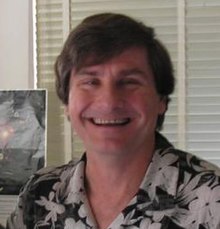Alex Filippenko
Alexei Filippenko | |
|---|---|
 | |
| Born | July 25, 1958 |
| Alma mater | University of California, Santa Barbara, B.A. California Institute of Technology, Ph.D. |
| Known for | Type Ia Supernova Studies |
| Awards | Newton Lacy Pierce Prize in Astronomy Guggenheim Fellowship |
| Scientific career | |
| Fields | Astrophysics |
| Institutions | University of California, Berkeley |
| Doctoral advisor | Wallace L. W. Sargent |
Alexei Vladimir Filippenko (born July 25, 1958) is an American astrophysicist and professor of astronomy at the University of California, Berkeley. Filippenko graduated from Dos Pueblos High School in Goleta, CA. He received a Bachelor of Arts in physics from the University of California, Santa Barbara in 1979 and a Ph.D. in astronomy from the California Institute of Technology in 1984, where he was a Hertz Foundation Fellow. He was a Miller Fellow at UC Berkeley and was subsequently appointed to a faculty position at the same institution. His research focuses on supernovae and active galaxies at optical, ultraviolet, and near-infrared wavelengths.
Research
Filippenko was a member of the Supernova Cosmology Project and the High-z Supernova Search Team that used observations of extragalactic supernovae to discover the accelerating universe. This universal acceleration implies the existence of dark energy and was voted the top science breakthrough of 1998 by Science magazine.[1]
Filippenko developed and runs the Katzman Automatic Imaging Telescope (KAIT), a fully robotic telescope which conducts the Lick Observatory Supernova Search (LOSS), the most successful nearby supernova search. He is also a member of the Nuker Team which uses the Hubble space telescope to examine supermassive black holes and determined the relationship between a galaxy's central black hole's mass and velocity dispersion.[2][3] The Thompson-Reuters "incites" index ranked Filippenko as the most cited researcher in space science for the ten-year period between 1996 and 2006.[4]
In the media
He is frequently featured in the History Channel series The Universe.
Honours and awards
Filippenko was awarded the Newton Lacy Pierce Prize in Astronomy in 1992 and a Guggenheim Fellowship in 2000. He was elected to the National Academy of Sciences in 2009. In addition to recognition for his scholarship, he has received numerous honors for his undergraduate teaching, including the 2007 Richtmyer Memorial Award given annually by the American Association of Physics Teachers and the Carl Sagan Prize for Science Popularization by Wonderfest in 2004.[5] In 2006 Filippenko was awarded the US Professor of the Year Award, sponsored by The Carnegie Foundation for the Advancement of Teaching and administered by the Council for Advancement and Support of Education (CASE).[6] The UC Berkeley student body voted him as their "Best Professor" on campus nine times.[7] Filippenko won the 2010 Richard H. Emmons Award for excellence in college astronomy teaching, issued by the Astronomical Society of the Pacific.[8] He was invited to give the 42nd Oppenheimer Memorial Lecture in 2012.[9]
References
- ^ James Glanz (18 December 1998). "Breakthrough of the Year: Astronomy: Cosmic Motion Revealed". Science. 282 (5397): pp 2156–2157. Bibcode:1998Sci...282.2156G. doi:10.1126/science.282.5397.2156a. Retrieved 2008-07-17.
{{cite journal}}:|pages=has extra text (help); More than one of|work=and|journal=specified (help) - ^ Tod Lauer (14 August 2007). "HST Investigations Into the Central Structure of Galaxies". National Optical Astronomy Observatory. Retrieved 2008-07-17.
- ^ Gebhardt, Karl (2000). "A Relationship between Nuclear Black Hole Mass and Galaxy Velocity Dispersion". The Astrophysical Journal. 539 (1): L13–L16. arXiv:astro-ph/0006289. Bibcode:2000ApJ...539L..13G. doi:10.1086/312840.
{{cite journal}}: Unknown parameter|coauthors=ignored (|author=suggested) (help); Unknown parameter|month=ignored (help) - ^ "Top 10 Researchers In Space Science:". In-cites. The Thomson Corporation. November 2006. Retrieved 2008-07-17.
- ^ "Sagan Prize Recipients". wonderfest.org. 2011 [last update]. Retrieved September 10, 2011.
{{cite web}}: Check date values in:|year=(help) - ^ Robert Sanders (16 November 2006). "Astronomer Alex Filippenko named national Professor of the Year". UC Berkeley News. University of California, Berkeley. Retrieved 2008-07-12.
- ^ "Alexei V. Filippenko Faculty Page". UC Berkeley. 2012. Retrieved 2012-06-08.
- ^ "ASP Annual Awards". ASP. 2010. Retrieved 2010-08-22.
- ^ Snodgrass, Rodger. "Distinguished astronomer to give Oppenheimer Lecture". Santa Fe New Mexican. Retrieved 31 August 2012.
External links
- Alexei Filippenko official webpage
- Introduction to General Astronomy – UC Berkeley Webcast
- Dark Energy and the Runaway Universe – UC Berkeley Webcast
- 1958 births
- Living people
- American astronomers
- California Institute of Technology alumni
- Guggenheim Fellows
- People from Oakland, California
- American people of Ukrainian descent
- University of California, Berkeley faculty
- University of California, Santa Barbara alumni
- American scientists of Ukrainian descent
- Members of the United States National Academy of Sciences
